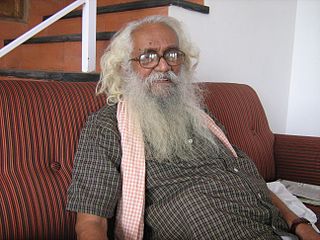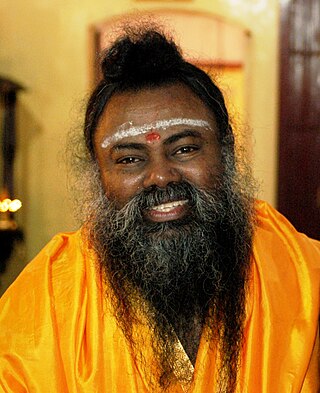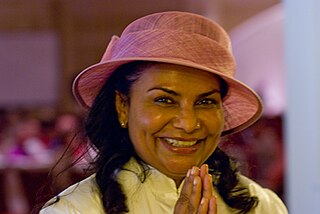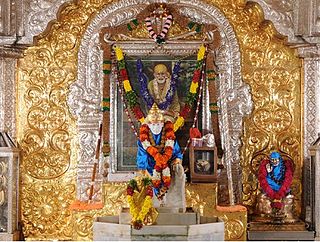
Sai Baba of Shirdi, also known as Shirdi Sai Baba, was an Indian spiritual master and fakir, considered to be a saint, revered by both Hindu and Muslim devotees during and after his lifetime.

Sathya Sai Baba was an Indian guru. At the age of fourteen, he claimed that he was the reincarnation of Shirdi Sai Baba, and left his home to accept his devotees.

Basava Premanand was an Indian skeptic and rationalist from Kerala, India. He organised many tours around rural India for the promotion of scientific thinking, exposing alleged miracles and scams carried out by various charlatans and godmen while spreading awareness of dangerous superstitions. Premanand was the founder of the Federation of Indian Rationalist Associations, the convener of Indian CSICOP, and the owner-publisher-editor of the monthly magazine The Indian Skeptic, which investigates paranormal claims in India.

In Spiritualism, paranormal literature and some religions, materialization is the creation or appearance of matter from unknown sources. The existence of materialization has not been confirmed by laboratory experiments. Numerous cases of fraudulent materialization demonstrations by mediums have been exposed.

Abraham Thomas Kovoor was an Indian professor and rationalist who gained prominence after retirement for his campaign to expose as frauds various Indian and Sri Lankan "god-men" and so-called paranormal phenomena. His direct, trenchant criticism of spiritual frauds and organized religions was enthusiastically received by audiences, initiating a new dynamism in the Rationalist movement, especially in Sri Lanka and India.

H. (Hanumanthappa) Narasimhaiah was an Indian physicist, educator, writer, freedom fighter and rationalist from Karnataka. Publicly known as "HN", he was the Vice-Chancellor of Bangalore University and the president of the National Education Society. He was conferred the Padma Bhushan award by the Government of India in 1984.

Indian CSICOP is a well-known rationalist group based at Podanur, Tamil Nadu, India. Founded by Basava Premanand (1930–2009). Indian CSICOP is in the forefront of the rationalist campaigns in India which attempt to expose perceived miracles and to eradicate superstitions.
The Indian Rationalist Association is a voluntary organisation in India whose 100,000 members promote scientific skepticism and critique supernatural claims. It publishes books and magazines, organises seminars and lectures and its representatives regularly appear in television and print media exposing superstitions. The present president of Indian Rationalist Association Sanal Edamaruku was elected in 2005. He was the General Secretary of the association from 1984 till 2005.

Prabir Ghosh was the founder and president of Bharatiya Bigyan O Yuktibadi Samiti, a science and rationalists' association based in Kolkata, India. He was the author of a number of books in Bengali disputing supernatural claims and was well known for his book series titled Aloukik Noy, Loukik.
Sri Sathya Sai Airport is located at Puttaparthi in the state of Andhra Pradesh, India. The airport is named after Sathya Sai Baba, a spiritual guru and philanthropist. It is a small airport with facilities for chartered flights rather than commercial aircraft. The airport was inaugurated in 1990 to serve the Sri Sathya Sai Institute of Higher Medical Sciences during emergency situations. The airport's 1000-metre-long airstrip and terminal building were constructed by L&T ECC. The runway was later extended to enable the operation of larger jet aircraft.
The Sathya Sai Baba movement is a new religious movement inspired by South Indian Neo-Hindu guru Sathya Sai Baba who taught the unity of all religions. Some of his followers have faith in his claim to be a purna Avatar of Shiva and Shakti, who is believed to have been predicted in the Bhagavad Gita. This means that some of his followers see him as a God. Devotees engage in singing devotional songs called "bhajans" and selfless service (seva). Its official organization is the Sathya Sai Organization. However the Sathya Sai Baba movement extends beyond the organization. An important aspect of the faith of adherents is the miracles attributed to Sathya Sai Baba. The number of adherents is estimated between 6 and 100 million.

Prem Kumar, better known as Swami Premananda, was a Sri-Lankan born Indian religious monk who founded the Premananda ashram. He was convicted of multiple counts of rape and a murder in 1997.
Siva Shankar Baba is a Hindu spiritual teacher from Tamil Nadu, India.

Sai Maa, also known as Sai Maa Lakshmi Devi Mishra, is a spiritual guru, businesswoman, energy healer and author. She is known among her followers as the 'Embodiment of the Divine Feminine' and has purported both omnipotence and omniscience. She has offered programmes on energy healing and personal transformation throughout North America, Europe and Asia. One of the central premises of her teachings is that the Earth, and its spiritually evolved human inhabitants, are ascending to a new dimension.
Superstition refers to any belief or practice that is caused by supernatural causality, and which contradicts modern science. Superstitious beliefs and practices often vary from one person to another or from one culture to another.
In October 2013, in Sangrampur village in the Unnao district of the Indian state of Uttar Pradesh, a local seer named Shobhan Sarkar dreamt that over 1000 tonnes of gold were buried under the ruins of an old fort of a 19th-century king, Ram Baksh Singh. Sarkar wrote to the President of India, the Ministry of Mines (India) and the Archaeological Survey of India (ASI) to consider excavation for the supposed hoard. The excavation work began on 18 October 2013. On 29 October 2013, the ASI announced that there was no gold buried in the location and stopped excavation work. More news was released on 29 October 2013, saying that ASI Director General Pravin Srivastava said the digging area was now planned to be widened, but clarified that the excavation work by his 12-member team had not been stopped. On 18 November 2013, ASI stopped the excavation and began filling up the trenches.

Sri Naga Sai Mandir is a Hindu temple dedicated to the Indian Spiritual Master Shirdi Sai Baba in Coimbatore in the Indian state of Tamil Nadu.

Maharashtra Rationalist Association was an organisation dedicated to spreading rationalism and humanism in Maharashtra, India, and was an integral part of the rationalist movement in Maharashtra. The organisation is succeeded by Mumbai Rationalist Association, which in turn has paved the way for Sunday Sapiens.

Modern yoga gurus are people widely acknowledged to be gurus of modern yoga in any of its forms, whether religious or not. The role implies being well-known and having a large following; in contrast to the old guru-shishya tradition, the modern guru-follower relationship is not secretive, not exclusive, and does not necessarily involve a tradition. Many such gurus, but not all, teach a form of yoga as exercise; others teach forms which are more devotional or meditational; many teach a combination. Some have been affected by scandals of various kinds.














